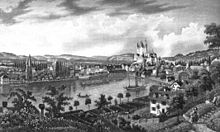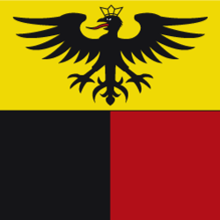Bernese Oberland

The Bernese Oberland (
The region essentially coincides with the upper basin of the Aare, the latter notably including Lake Thun and Lake Brienz, the two large lakes of the region. On the banks of the lakes or the Aare are the main settlements of Thun, Spiez, Interlaken, Brienz and Meiringen. The numerous side valleys of the Bernese Oberland include a large number of Alpine villages, many of them being tourist resorts and connected by mountain railways to Spiez and Interlaken. The Lötschberg, a major north-south axis through the Alps, links the region with both the capital of the canton, Bern, and its sizable southern neighbour, the canton of Valais.
The flag of the Bernese Oberland consists of a black eagle in a gold field (in reference to the region's old status as
The
In the short-lived Helvetic Republic (1798–1803), the Bernese Oberland was a separate canton.
History
Prehistorically the Bernese Oberland was crossed by hunters or traders, but the first known settlements were from the
.During the

The expansionist policy of the city of
During the Middle Ages, the settlement pattern in the Bernese Oberland was somewhat consistent. A main settlement grew on the valley floor below an elevation near 1,100 m (3,600 ft). This main settlement had a market and often a castle or other fortifications. This
After the

The 1801
In 1729, Albrecht von Haller published the poem Die Alpen about his travels through the alpine regions. This combined with other reports and alpine paintings started the tourism industry in the Bernese Oberland. By 1800 there were resorts on Lake Thun and Lake Brienz (especially at Interlaken between the two lakes). Shortly thereafter the resorts expanded into the alpine valleys (Lauterbrunnen, Grindelwald), and began attracting English guests. However, because of the widespread poverty of the 19th century many residents of the Simmen valley and the Interlaken district emigrated to North America, Germany or Russia.
In the late 19th century, new transportation links made it easier for people to travel into the valleys. The
Geography



The Bernese Oberland designates primarily an area around the upper valley of the
Its largest part and the Alpine part of the Aare before the river enters
Above of Brienz on the northeastern shore of Lake Brienz soars the Brienzer Rothorn, the highest summit of the 30-kilometre-long (19 mi) prominent mountain range dominating the north shore of the Lake Brienz as far as its western end above Interlaken with the Harder. The easternmost section of the ridge constitutes the border with the canton of Lucerne (LU), but the western part is fully in Bernese territory. The region of Habkern, north of the Harder, is one of the few valleys on the right side of the Aare.
South of Interlaken the short valley of the
On the southeastern side of the mountain range formed by Eiger, Mönch and Jungfrau lies the head of the largest glacier of the Alps, the
Zweisimmen also connects to
The
North of Spiez, right across Lake Thun, on its northern shore, lies the Niederhorn, the south end of the northernmost mountain range of significant elevation of the Bernese Oberland, with the Gemmenalphorn and the Hohgant at the other end, separated by a small valley from the Harder on its southeast.
At the west end of Lake Thun, at the outlet of the river Aare, lies the town of Thun, which already belongs to the Swiss Plateau, not far from Bern to the northwest.
Administrative division


Since 2010, the Bernese Oberland covers one of five administrative regions of the canton of Bern (called German: Verwaltungsregion Oberland)[5] and consists of four administrative districts with 80 municipalities:[6]
- Frutigen-Niedersimmental (administrative district)
- Interlaken-Oberhasli (administrative district)
- Obersimmental-Saanen (administrative district)
- Thun (administrative district)
Before 2010, the Oberland had consisted of the following districts:[citation needed]
- Thun (district)
- Interlaken (district)
- Oberhasli (district)
- Frutigen (district)
- Obersimmental (district)
- Niedersimmental (district)
- Saanen (district)
Tourism
The Bernese Oberland is well known for touristic reasons, including the following destinations:
- Gstaad-Saanenland
- Lenk/Simmental
- Adelboden-Frutigen
- Lake Thun
- Lötschberg area
- Interlaken
- Lauterbrunnental
- Grindelwald
- Haslital
See also
References
- ^ a b c Bernese Oberland in German, French and Italian in the online Historical Dictionary of Switzerland.
- ^ Böser Bund in Bernese Oberland in German, French and Italian in the online Historical Dictionary of Switzerland.
- ^ Canton of Oberland in German, French and Italian in the online Historical Dictionary of Switzerland.
- ^ Swisstopo maps
- ^ "Karte der Verwaltungskreise und Verwaltungsregionen" (PDF) (PDF) (in German). Thun, Bern: Justiz-, Gemeinde- und Kirchendirektion, Canton of Bern. 1 January 2015. Retrieved 2015-10-14.
- ^ "Regierungsstatthalterämter" (in German). Thun, Bern: Justiz-, Gemeinde- und Kirchendirektion, Canton of Bern. Retrieved 2015-10-14.
External links
 Media related to Berner Oberland at Wikimedia Commons
Media related to Berner Oberland at Wikimedia Commons- Tourist office of the canton of Bern
